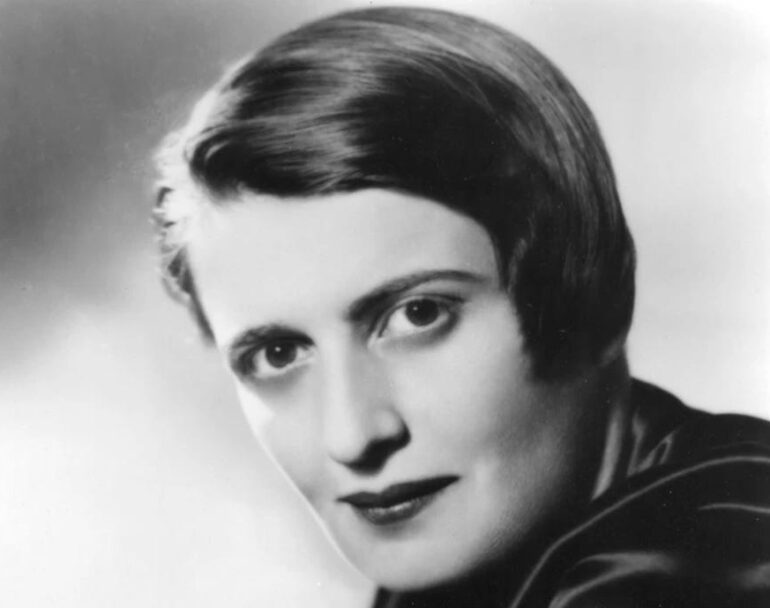
What Ayn Rand Meant by “Americanism”
by Dan Sanchez
In 1946, a Russian immigrant to America tried to remind her fellow citizens what America was all about. A publication called The Vigil printed an article that was meant to be the first in a series called Textbook of Americanism. (No further installments were ever published.)
The author was Ayn Rand.
As a young girl growing up deprived in Soviet Russia, Rand fell in love with America through its movies. America’s individualist values and heroic achievements contrasted starkly with the collectivist values that dominated Russia and the bitter fruits of communism. As a young woman in 1926, she made her dreams come true by immigrating to the US where she would build a career as a movie screenwriter in Hollywood.
But to Rand’s dismay, she later witnessed collectivism metastasizing in America, not only in its policies (as in the New Deal), but in its stories: especially in literature and film. And so she set out to save her adopted home from the fate of her native country by championing individualism and exposing collectivism through her writing: especially her novels. Her breakthrough work was The Fountainhead, published in 1943.
While Textbook of Americanism was a work of non-fiction, its objective was to improve the stories we tell ourselves by reminding the movie industry about America’s original ideals. The Vigil (as mentioned, the venue in which it appeared) was a publication of the Motion Picture Alliance for the Preservation of American Ideals.
As Laurie Rice wrote for FEE in her 2014 introduction to Textbook of Americanism:
“This organization consisted of a number of prominent conservative figures in Hollywood, including Ronald Reagan, Walt Disney, Gary Cooper, Ginger Rogers, Clark Gable, and John Wayne.
The alliance’s immediate purpose was to assemble well-known people as witnesses to a congressional investigation of the motion picture industry. The alliance’s longer-term mission was to organize the motion picture industry’s pro-freedom figures to defend their field against the ideas of communism. Movies in Hollywood at the time frequently portrayed Russia and communism sympathetically, or spread implicit communist messages within other stories.
‘Textbook of Americanism’ was written toward this bigger goal, with Rand calling for the values of individualism and freedom to be portrayed in her beloved movie industry.”
Rand opened the work by presenting a stark dichotomy:
“The basic issue in the world today is between two principles: Individualism and Collectivism.
Individualism holds that man has inalienable rights which cannot be taken away from him by any other man, nor by any number, group or collective of other men. Therefore, each man exists by his own right and for his own sake, not for the sake of the group.
Collectivism holds that man has no rights; that his work, his body and his personality belong to the group; that the group can do with him as it pleases, in any manner it pleases, for the sake of whatever it decides to be its own welfare. Therefore, each man exists only by the permission of the group and for the sake of the group.
These two principles are the roots of two opposite social systems. The basic issue of the world today is between these two systems.”
Rand identified America as an example of the first system, rooted in the principle of individualism as articulated in the Declaration of Independence. And she identified “Soviet Russia and Nazi Germany” as examples of the second system, rooted in the principle of collectivism:
“Under the Soviet system, millions of peasants or “kulaks” were exterminated by law, a law justified by the pretext that this was for the benefit of the majority, which the ruling group contended was anti-kulak. Under the Nazi system, millions of Jews were exterminated by law, a law justified by the pretext that this was for the benefit of the majority, which the ruling group contended was anti-Semitic.
The Soviet law and the Nazi law were the unavoidable and consistent result of the principle of Collectivism.”
Rand then presented the bedrock idea of “Americanism”:
“The basic principle of the United States of America is Individualism.
America is built on the principle that Man possesses Inalienable Rights;
- that these rights belong to each man as an individual—not to “men” as a group or collective;
- that these rights are the unconditional, private, personal, individual possession of each man—not the public, social, collective possession of a group;
- that these rights are granted to man by the fact of his birth as a man—not by an act of society;
- that man holds these rights, not from the Collective nor for the Collective, but against the Collective—as a barrier which the Collective cannot cross;
- that these rights are man’s protection against all other men;
- that only on the basis of these rights can men have a society of freedom, justice, human dignity, and decency.”
Rand clearly did not posit “Americanism” as a breed of partisan nationalism. Rand’s Americanism was not blind support for whatever specific American individuals or governments desire or do. “Americanism” referred to the founding American tradition—as articulated in America’s founding document, the Declaration of Independence—of upholding the principle of individualism: that is, of individual rights.
Americanism isn’t a matter of where you live or which government rules over you. It’s a matter of whether we each understand the ideas and live up to the ideals upon which America was founded.